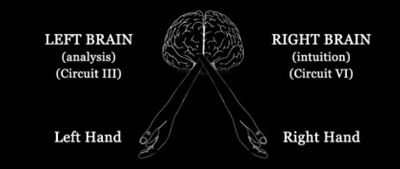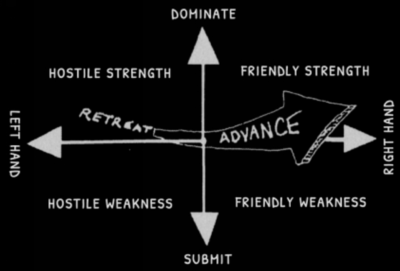The left-right polarity between cerebral hemisphere and hand funtioning places us in three-demensional space
The Time-Binding Semantic Circuit seems intimately connected with three dimensionality (although our binocular vision, of course, also plays a role here). Specifically, right-handedness is a human, or at least a primate, trait. Other mammals show no right-hand preference; they are ambidextrous. Recent neurology has shown that our right-handedness is intimately connected with our tendency to use the left cortex of the brain more than the right. Thus, there is a genetic (hard-wired) preference, in most humans, for right-handed manipulations and left cortex mentations. Some left-handed people contrarily specialize in right cortex functions, which are holistic, supra-verbal, “intuitive,” musical and “mystical.” Leonardo Da Vinci, Ludwig Beethoven and Fredrich Nietzsche, for instance, were all left-handed. Traditionally, left-handed people have been the subject of both dread and awe—regarded as weird, shamanic, and probably in special communication with “God” or “the Devil.” Aleister Crowley knew about this pragmatically, before modern neurology. He taught his pupils to learn to write equally well with both hands, thereby activating the right cortex. There is thus a cross-over which makes for a left-right polarity in both brain-functioning and hand-functioning, each being a reverse mirror image of the other:

This double (and reversed) right-left polarity places us neurologically in three-dimensional space. Rearranging our diagram and adding the Time-Binding Semantic Circuit, we can illustrate the mind-field as follows:

This is “Euclidean” space. It is obvious, in this context, why Euclidean space was the first kind of space identified by mathematicians, and by artists, and why it still seems “natural” to us; why some have great difficulty in imagining the non-Euclidean kinds of space used in modern physics. Euclidean space is a projection outward of the way our nervous systems stacks information on the bio-survival, emotional and semantic circuits.
References
- Wilson, A., Robert. Prometheus Rising Chapter 6 The Time-Binding Semantic Circuit (Location 1078). Grand Junction, Colorado: Hilaritas Press.
Metadata
Type:🔴 Tags: Biology / Neuroscience / Physiology / Neurophysiology / Sociobiology Status:☀️